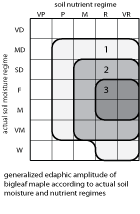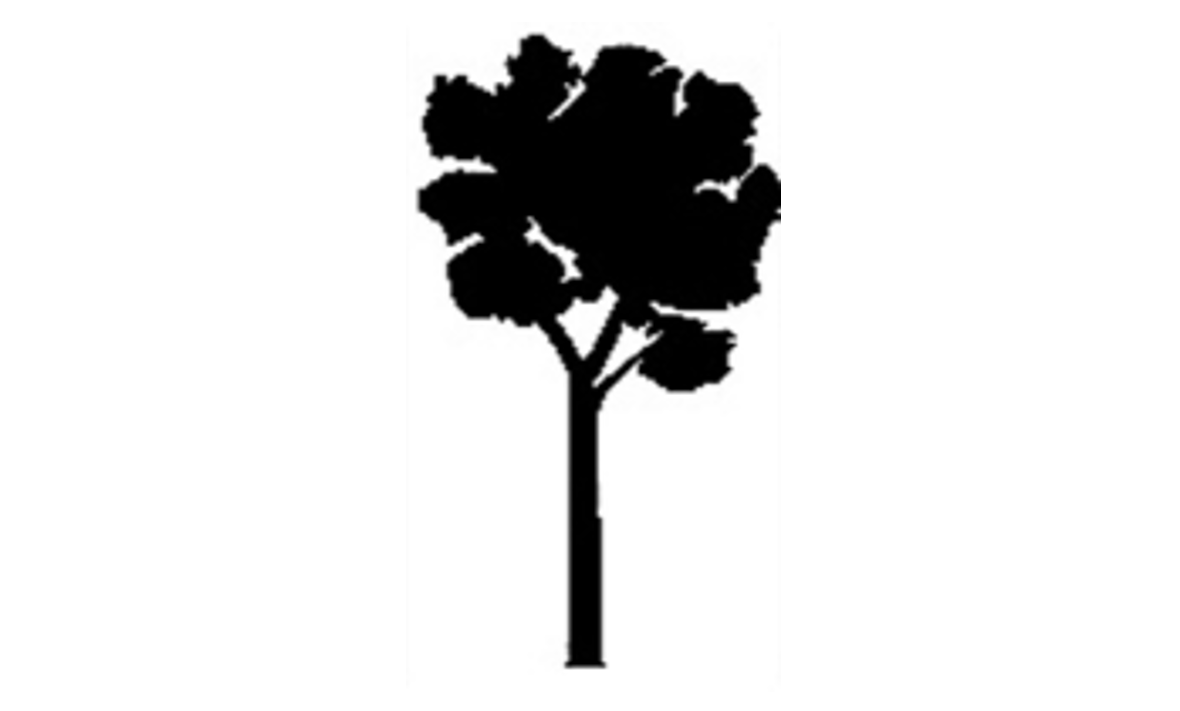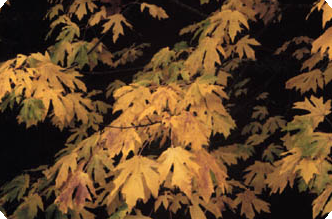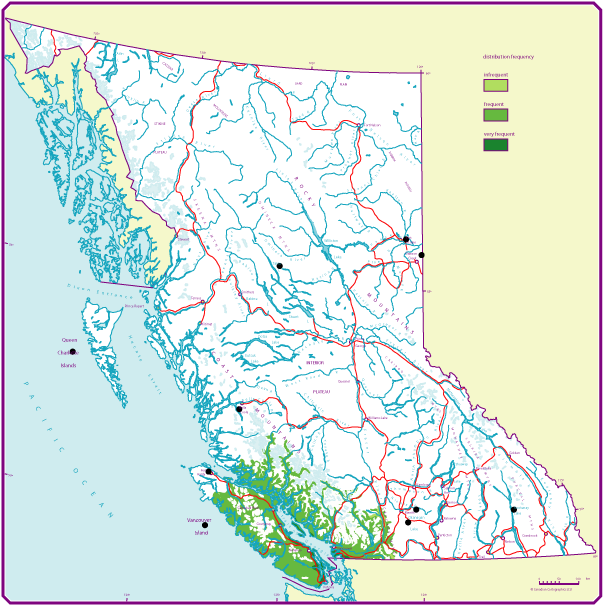Bigleaf maple
On this page
- Geographic range and ecological amplitudes
- Tolerances and damaging agents
- Silvical characteristics
- Genetics and notes
Geographic range and ecological amplitudes
Description
Bigleaf maple is a medium-sized (<30m tall), deciduous, broad-leaved tree, at maturity with a broad, rounded crown, often curved stem (in the open, the stem soon divides into a few large spreading and ascending branches), and grayish-brown bark which is shallowly furrowed into narrow scaly ridges. Like sugar maple, bigleaf maple has sweet sap that can be made into syrup. Its wood is used for furniture, flooring, interior paneling, and musical instruments.
Geographic range
Geographic element:
Western North American/mainly Pacific and less Cordilleran
Distribution in Western North America:
central and south in the Pacific region; (central) in the Cordilleran region
Ecological amplitudes
Climatic amplitude:
(subcontinental cool temperate) - cool and warm mesothermal
Orographic amplitude:
submontane - (montane)
Occurrence in biogeoclimatic zones:
(subcontinental IDF), CDF, southern CWH
Edaphic amplitude

Range of soil moisture regimes:
(moderately dry) - slightly dry - fresh - moist - very moist - (wet)
Range of soil nutrient regimes:
(poor) - medium - rich - very rich
Nutritional requirements of bigleaf maple appear to be high, especially for nitrogen (mainly nitrates), calcium, magnesium, potassium, and phosphorus. As a consequence, (i) its bark is rich in calcium that provides substrate for the establishment of many corticolous calciphytic bryophytes, and (ii) its litter contributes to the nutrient status of forest floor by increasing its nitrogen, calcium, and magnesium concentrations. Thus, the presence of bigleaf maple in coniferous stands will tend to improve humus form quality from Mors to Moders, which have higher decomposition and mineralization rates, and higher levels of plant-available soil nutrients.
Tolerances and damaging agents
Root system characteristics
Bigleaf maple has a shallow but wide-spreading root system. Roots are associated with vesicular-arbuscular mycorrhizae.
| Tolerance to | Tolerance class | Comments |
|---|---|---|
| low light | L | moderately shade-tolerant in the early development stage |
| frost | L | not a major concern in mesothermal climates |
| heat | M | frequent on insolated sites |
| water deficit | L | like red alder, responds to drought by shedding its leaves |
| water surplus | H | common on wet sites, floodplains, and sites with a strongly fluctuating water table |
| nutrient (mainly N) deficiency | M | absent in acid, very poor soils |
| Damaging agent | Resistance class | Comments |
|---|---|---|
| snow | L | snowfall is low in submontane, maritime, cool mesothermal climates |
| wind | M | high winds will break the boles rather than uproot trees |
| Risk class | ||
|---|---|---|
| fire | L | Low risk in pure bigleaf maple stands |
| insect | L | Not a major risk |
| fungi | L | Not a major risk in undamaged trees |
| other agents | L | Browsing by deer and elk is not a major risk |
Associated tree species and successional role
In British Columbia, bigleaf maple grows occasionally in even-aged, pure stands, but most commonly in early and intermediate stages of secondary succession mixed with conifers or hardwoods. It is a pioneer species (primary succession) on talus and floodplains, and is present in second-growth stands on upland sites. Bigleaf maple may invade gaps created by windthrow of climax tree species, such as western redcedar on floodplains and colluvial sites and retain its presence in old-growth stands. It frequently grows in clumps of 3 to 5, all originating from a single stump.
| Associated tree species |
Occurance class | Major area of occurance |
|---|---|---|
| red alder | L | floodplains in southwestern B.C |
| black cottonwood | L | floodplains in southwestern B.C |
| common douglas | L | southwestern B.C |
Genetics and notes
Genetics
Two varieties are recognized: Kimball maple (Acer macrophyllum Pursh var. kimballi Harrar) and Acer macrophyllum Pursh var. rubrum Murray.
Notes
In some individuals of bigleaf maple, the grain patterns are unsurpassed, even by walnut, suggesting a potential for use in furniture. Considering its productivity, easy regeneration, and low risk of being affected by damaging agents, bigleaf maple is a suitable species for intensive management on some coastal sites (for example, skeletal alluvial fans, fragmental colluvial slopes, stream-edge sites, and floodplains). Considering its wildlife and aesthetic values and soil improvement capacity, it is a useful short-term or even a long-term, minor admixture in coniferous stands, such as common douglas stands, in southwestern B.C.
There are two other shrub-sized maple species: vine maple (Acer circinatumPursh) and Douglas maple (Acer glabrum Torr.), the latter of which may attain small tree size. While the range of vine maple is restricted to the southern coastal mainland, Douglas maple occurs throughout central and southern B.C., except the outer coastal region. Both species are shade-tolerant and their litterfall, like that of bigleaf maple, improves humus form quality. More detailed silvics information is given by:
Minore, D. and J.C. Zasada. 1990. Acer macrophyllum. Pp. 33-40 in R.M. Burns and B.H. Honkala (technical coordinators) Silvics of North America, Vol. 2. Agri. Handbook 654, USDA For. Serv., Washington, D.C.

This is the general shape and outline of the bigleaf maple.

Bigleaf maple mostly occurs in maritime climates of southwestern B.C., where it grows predominantly on colluvial slopes or alluvial landforms. In most fall seasons the leaves of bigleaf maple turn brown, but during a sunny autumn, the leaves turn yellow - never red.

